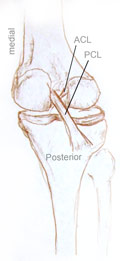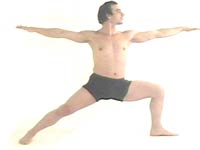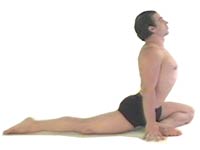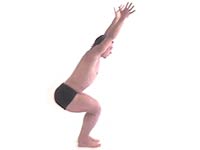ACL injury – Meniscus injury – Patella Tracking
Many motions and positions in Yoga can harm the knees and aggravate a condition. Seek professional help when a knee injury is suspected or knee pain is present (especially for a prolonged period of time). A good physical therapist should be able to easily diagnose the problem but devices that allow professional to see inside the knee should also be used to determine the exact cause and take the appropriate surgical action. Get a second opinion to prevent miss-diagnosis.

![]()
If pain presents itself while entering any of these knee exercises immediately. If pain that was present worsens while entering stop immediately and modify. Monitor your response the next day and if no pain is present the exercises have been successful. The aim is to increase good range of motion and strength in the knee joint without aggravating a condition.
![]()
Knee Injury Modifications for Yoga Postures
Use caution if you have a knee injury and are participating in a yoga class. Make modifications to the postures shown below so that beneficial responses result from performing them.
![]()
Postures that involve deep bending of the knee can be hard on the joint and aggravate a knee condition. Let us look at some examples below.
![]()

Virabhadrasana 2 – Warrior 2 Pose is an example of a standing posture that is too deep for a knee injury or a knee with knee pain. Performing the pose with such a deep angle would have a negative response to knee rehabilitation and would probably cause greater pain within the knee. A posture done with a 45 degree angle rather than 90 degree angle would be helpful to knee stability and aid in strengthening.
When performing exercises for knee strength be sensible. Find a stance with a width in the feet that is not to hard on the knee or not too much strain on the quadriceps but enough to tone. The width may vary from person to person.
Open leg stances require flexible adductor muscles. These are the groin muscles and they have a tendency to pull the knee inward when performing such postures. This destabilizes the knee joint and prevents proper use of it. Be aware of this when these posture. Glance down at knee and align it with the ankle vertically.
Maneuver the knee slightly forward and back over the ankle to find a point. This will also stimulate blood flow in the joint which promotes healing.
![]()
Make sure you are well supported for balancing postures. Use a block or prop to prevent knee instability while performing these postures. If the hamstrings are quite flexible there is no need for a prop.
![]()
It strengthens the knee if the supporting leg is slightly bent. Then it is also easier to hold the posture especially if the hamstrings are inflexible.
![]()
It may be a good idea to avoid balancing postures if there is a lot of inflammation present in the knee joint. Try them and feel if the knee joint is ok. There is a lot of weight falling upon the joint. The hamstring stretch is however beneficial.
![]()
Many knee injuries are aggravated by the yoga postures below.
 Salamba Kapotasana – Supported Pigeon
Salamba Kapotasana – Supported Pigeon
Supporting the upper body weight across the fingers will result in a reduction of strain in the knee. For this reason it may be a good idea to use support when performing this kind of posture in yoga. Meniscal cartilages vulnerable during these kind of postures. Moving the foot on the bent leg forward further will stretch the knee more. For this reason keep it tucked under the top of the opposite leg and reduce the twist in the knee.
When a knee injury is present or persistent knee pain has been occurring modify by moving the knee into the midline and use the elbows for support. Place the hands and forearms down on both sides of the knee joint. This will reduce the strain on the knee but continue to stretch the hip.
![]()
 Utkatasana – Chair pose
Utkatasana – Chair pose
This yoga posture is very healthy for building strength in vital muscles in the knees.
Be safe and avoid over bending the knees. This will cause unnecessary joint strain. Find a pleasant boundary that tightens and tones the quadriceps muscle in the front of the thigh.

 Janu Sirsasana and Parivrtta Janu Sirsasana involve knee flexion and mild rotation. This may aggravate a swollen knee or a knee that is sensitive.
Janu Sirsasana and Parivrtta Janu Sirsasana involve knee flexion and mild rotation. This may aggravate a swollen knee or a knee that is sensitive.
![]()

 The same benefits to hamstring flexibility can be achieved with both legs straight out. This may be a better option in a yoga class if a knee condition exists.
The same benefits to hamstring flexibility can be achieved with both legs straight out. This may be a better option in a yoga class if a knee condition exists.
![]()
![]()
![]()
 Other Yoga postures that may aggravate knee pain further are intense knee bending accompanied by an external rotation of the lower leg. This may not be suitable for people with inflexible knees. Instead have both feet crossed in front and be seated on a cushion or blanket to reduce knee strain.
Other Yoga postures that may aggravate knee pain further are intense knee bending accompanied by an external rotation of the lower leg. This may not be suitable for people with inflexible knees. Instead have both feet crossed in front and be seated on a cushion or blanket to reduce knee strain.
![]()
![]()
 Yoga postures
Yoga postures
that involve deep knee bending for long periods of time can aggravate knee injuries and cause swelling. The knees get stiff after being injured. It is good to stretch them mildly and not for too long. Circulation is important to healing. Use a prop or cushion to reduce the strain on the knees if you are performing this posture.
![]()

Balasana the Child Pose in Yoga can be a good way to stretch the knee joints.
It may not be a good idea to enter a boundary as deep as shown. When performing this pose bend the knees into a mild boundary where the tension feels good. Enter slowly as the upper bodies weight is behind the movement into the pose.
![]()
 Paschimottasana is a seated forward bend in Yoga. It is a good way to stretch the hamstrings and if the toes are drawn towards the body the calf muscles and the achilles tendons.
Paschimottasana is a seated forward bend in Yoga. It is a good way to stretch the hamstrings and if the toes are drawn towards the body the calf muscles and the achilles tendons.
![]()
![]()
 Adho Mukha Svanasana which is known in Yoga as Downward Facing Dog
Adho Mukha Svanasana which is known in Yoga as Downward Facing Dog
stretches the hamstrings, calf muscles and achilles tendons. This pose is a great way to balance and stretch the posterior leg muscles. Bend one knee a little and alternate on each leg for a slightly deeper stretch on the leg muscles.
![]()
 Uttanasana which is a standing forward bend is a good way to stretch posterior leg muscles. The knees can be slightly bent while performing this exercise if the hamstrings are really tight or alternate by bending one knee and then the other. This can be a great way to stretch behind the knee.
Uttanasana which is a standing forward bend is a good way to stretch posterior leg muscles. The knees can be slightly bent while performing this exercise if the hamstrings are really tight or alternate by bending one knee and then the other. This can be a great way to stretch behind the knee.
![]()








